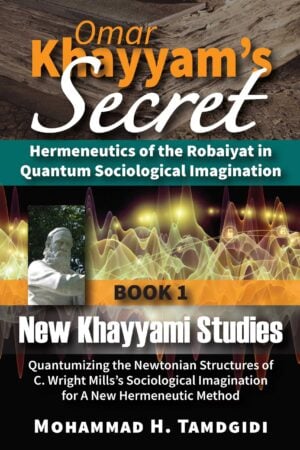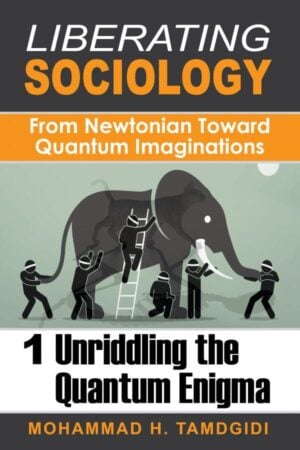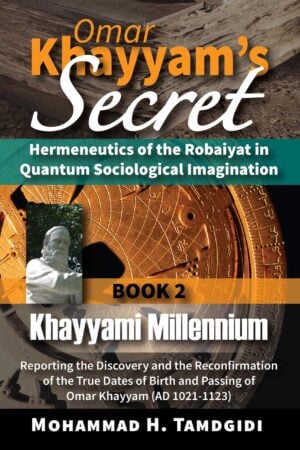Book Section: CHAPTER VIII — The Ontological Structures of the Robaiyat in Omar Khayyam’s Treatise on the Science of the Universals of Existence — by Mohammad H. Tamdgidi
$20.00
This essay, titled “The Ontological Structures of the Robaiyat in Omar Khayyam’s Treatise on the Science of the Universals of Existence” is the eighth and final chapter of the book Khayyami Philosophy: The Ontological Structures of the Robaiyat in Omar Khayyam’s Last Written Keepsake Treatise on the Science of the Universals of Existence, which is the fourth volume of the twelve-book series Omar Khayyam’s Secret: Hermeneutics of the Robaiyat in Quantum Sociological Imagination, authored by Mohammad H. Tamdgidi.
Description
Abstract
This essay, titled “The Ontological Structures of the Robaiyat in Omar Khayyam’s Treatise on the Science of the Universals of Existence” is the eighth and final chapter of the book Khayyami Philosophy: The Ontological Structures of the Robaiyat in Omar Khayyam’s Last Written Keepsake Treatise on the Science of the Universals of Existence, which is the fourth volume of the twelve-book series Omar Khayyam’s Secret: Hermeneutics of the Robaiyat in Quantum Sociological Imagination, authored by Mohammad H. Tamdgidi.
In this last chapter of Book 4 of the series, Tamdgidi draws on the findings of the previous chapters of this volume to explain how the worldview Omar Khayyam shared in his last written keepsake treatise on the universals of existence reveals in latent form the basic ontological structure of a collection of poetry he may have written such as the Robaiyat.
In the author’s view, Khayyam has basically rejected in his last treatise the notion of existence of an other-worldly afterlife (and of any paradise, hell, or judgment days in another world). In Khayyam’s view, this world is all there is, other than, of course, the Necessary Existence of God, which can alone in his view be considered an “other world.” Khayyam is basically stating that besides God’s Necessary Existence, all that exists is this world of possible existence that has come true and been actualized by God’s act of creation. This explains why we do not find any discussion at all of an other-worldly afterlife, nor of any conventional notions of otherworldy judgment day, heaven, or hell, in the treatise.
What Khayyam does discuss in terms of “hell” in the last (often omitted) clause of the treatise is in fact discussed as this-worldly experiences or degrees of hell, further proving the above hermeneutic interpretation of his text. Besides, the closest he comes to the highest experience of pleasure and reward humankind can ever experience and receive in terms of a paradise is that of knowing God and experiencing His presence in this world. It is in reference to God that Khayyam quotes from Islam’s prophet, suggesting that God makes His presence known to us everyday, the question being whether we ourselves pay attention to them.
The above does not mean at all that Khayyam did not believe in another world, nor does this mean he did not believe in the existence of hell, heaven, and judgment day(s). On the contrary, he believed in them, and did so from a very rational point of view, in fact. He simply interpreted their existence differently, having his own alternative Islamic point of view of them. For Khayyam, there is absolutely and definitively another world, and that “other world” is God’s Necessary Being. That world cannot be anything but absolutely good. Therefore, no hell or judgment day as such can exist in that world and be associated with that world, since no division or multiplicity is assumed to exist in God.
Also, for Khayyam, hell, paradise, and judgment day(s) definitively exist. But they exist as this-worldly existents. Paradise and hell are what we experience in this world. We in fact live them every single moment and day. We do not have to experience hell, but we can, if we do not awaken to the place we have in the succession order. Every day is a judgment day. Each moment can be a moment of judgment, which can result in our moments of heavenly or hellish experience. For Khayyam judgment days, heavens and hells are not postponed until an uncertain future. They already exist in our everyday here-and-nows.
So, the question that arises is this. How can we turn our this-worldly existence into a good, heavenly experience, away from evil and hellish suffering? How can we live our daily judgments such that the good outcome deserving humankind is perfectibly reached. This leads Tamdgidi to ask: What could be the ontological structures of any poetry collection Khayyam may care to compose, and why and for what ends would he composed them?
1. The collection would be a self-contained effort in seeking self-knowledge, advanced in a creative way. It would be an effort in seeking self-knowledge for the purpose of meditative self-purification, self-integration, and self-transformative healing. It would be self-contained in the sense that all that needs to be said are shared in the collection itself.
2. The collection would not be marginally put together, done in an incidental way for pastime. It would not be simply some poems jotted down on the margins of other works. It would be a record of serious, long-standing, inner work. The whole purpose of the collection would be integration, not (continued) disintegration. Similarly, we should expect that were Khayyam—the synoptic writer and teacher who, after the fashion of “the ancients,” limits his works to universal matters—to compose a collection of poetry, he would offer a highly organized, systematic collection, precise in its logical architecture, and purposeful in going about in meeting its goal.
3. While the collection would be comprised of separate “chapters” that are themselves relatively self-contained, self-reflective, creative insights, each of its parts would not be adequately comprehensible apart from the collection as a whole. Each part in the “succession order” of the collection would advance a particular insight needing to be integrated into the overall vision, and therefore could not be on its own regarded as representing the views of the collection’s author as a whole.
4. The most significant challenge a poetry collection from Khayyam would face is a continual, persistent, drawing of the attention of its author and possible audience to the here-and-now, warning of possible death at any time, reminding us of stealing any chance before we are stolen by death. The challenge would be to awaken from a state of living in trance of everyday life, not postponing it to tomorrow, so to speak, since at any moment, the body can pass away, leaving the task of spiritual fulfillment incomplete.
5. A collection of short quatrains, for instance, offers a chance of conveying a simple point or idea for the awakening task, that meets its goal as far as that specific point is concerned, in the context of its meaning in the collection as a whole. A quatrain style would begin with a simple idea and offer its awakening jolt on its last two lines.
6. Such a collection would not involve what Khayyam may have used in a one-sided way in his mathematical treatises, or even his more abstract and “universally” inclined philosophical and religious treatises. Here, details are important, but still these details are universally framed so as to evoke the author’s efforts at cosmic self-knowledge as a member of the human species, and the same in his potential audience.
7. The reason the collection used for spiritual awakening is a collection of poems would not be incidental, but essential. It would be poetic not simply as a matter of marginal choice or spontaneous recreative decision, but one that is done consciously and intentionally according to a well-thought out and precisely planned purpose. Choosing poetry as a style for this purpose, in other words, is as precisely considered and decided as conducting research on algebraic equations. Being a poet for him in its art form would be as much a scientific choice as it is a philosophical as well as a religious/spiritual engagement.
8. The language of poetry allows for simultaneous ways of both knowing, feeling, and sensing. What a philosopher knows, a poet sees. What one thinks of, the other imagines. To enable such a “shared” way of communicating the same topic, metaphors are used. The metaphor makes an abstract concept tangible, making it also emotionally and sensibly more accessible. A divisible state of fragmentation becoming an indivisible state of coherence can be expressed as a difference between grapes and wine. The difference between spirit as a self-reflective substance uniting intellect and self, on one hand, and the body, on the other, can be expressed as a difference between the wine and the cup. The difference between a specific point, a wider theme, and an entirety of a collection can be expressed as a difference between the sip, a cupful, a jugful, or a barrelful of wine. The bittersweet experiences of life can be expressed as the bittersweetness of wine. Wine’s enduring nature can be a metaphor for a lasting spiritual life.
9. When considering the use of metaphors in poetry in a self-reflective, creative way, however, it is also possible to treat the poetry itself as a subject of the metaphor. It is true that in a poem we could use wine as a metaphor for spiritual wisdom; however, it is also possible for the wine used as the metaphor to be a signifier for that poem itself specifically. This would offer us an example for what Khayyam calls a “discreet” language, even coupled with the “shared” form.
The skilled poet can use the wine in a poem to mean a whole series of things, differently evoked depending on the different ways different readers interpret the same poem. One takes “wine” to be wine literally. Another, it would stand for enjoying this worldly life. It would mean spiritual wisdom to yet another reader. And still, to another reader, it could mean the very poem, or collection of poetry, in which that metaphor is being used. And still yet to another poet skillfully using the term in both the discreet and shared way, the term could mean all the above, alternately, or even at once.
Using the metaphor as such would signify a different kind of logic at work. It would not be formal, Aristotelian, logic. It would be dialectical logic, skillfully containing opposite or different meanings in the same metaphor at once. A skilled poet with highly refined and scientifically sharpened sense could use the metaphor to hide the deepest of secrets in what would otherwise be a simple poem about mundane everyday life. He can skillfully hide the most secret of ideas in plain site.
10. A poetry collection that is kept secret, for personal as well as public reasons of the times, but is made known to exist, can generate questions and curiosities among friends and foes. The poet who regards the universe itself as a mysteriously created substance by an equally mysteriously hidden God, engendering eons of search by a ten-fold or infinite triads of self-reflective spheres in search of their Beloved Source above, would readily appreciate pursuing a similar effort in spiritual self-purification and development below, by way of a poetry collection that can have a potential to attract like a magnet and spread like a brush fire among a wide audience in his afterlife, in the interest of attaining enduring spiritual immortality across the generations—such that a thousand years from his time of birth, there could still be living in the lives of others, including in these lines.
For humankind to Drink the intoxicating Wine of love for its Beloved Source, it must make every effort to find a way of linking with the spiritual Wine-Tender, the Saqi—to be served by the first active intellect spiritualizing the entire universe in all its triadic ten-folds, at the bottom of whose succession order it has been given a brief lifetime’s chance to discover itself as a microcosm of the whole universe. The Wine of such a spiritual Wine-Tender is always there; it is we who have gone astray and are unable to hear or receive its subtle energies wishing to fill our cups.
Tamdgidi concludes that Khayyam’s worldview as presented in his last treatise represents a paradigmatic closing of a dualism another Persian sage, Zoroaster, introduced to world culture, one that has informed many of the world’s spiritual traditions across millennia. Khayyam has perceptively transcended a dualism that was invented, paved with good intentions, by Zoroaster, one that resulted otherwise in also much epistemic and social harm down the generations, when misunderstood.
Khayyam found in Islam’s heart a message that has aimed also at transcending the dualism. In Islam as he interpreted its essential message one does not have to choose between a suffering in this life and a good life in the hereafter. One can enjoy a life worthy of human values in this world and enjoy it while seeking spiritual fulfillment in this world as well. The rewards are not mutually exclusive. It is not a zero-sum game.
The genuine message Omar Khayyam found in Islam is that from an Absolute God nothing but goodness can come. This world is also meant to be a place for a good life that serves the high purpose of reaching the highest spiritual fulfillment that is the knowledge of God and experiencing the presence of the Beloved Source in this very lifetime—to know who we are, where we came from and where we can go to, by stealing any chance we can in the here-and-now, before it is too late.
Recommended Citation
Tamdgidi, Mohammad H. 2021. “CHAPTER VIII — The Ontological Structures of the Robaiyat in Omar Khayyam’s Treatise on the Science of the Universals of Existence.” Pp. 321-346 in Omar Khayyam’s Secret: Hermeneutics of the Robaiyat in Quantum Sociological Imagination: Book 4: Khayyami Philosophy: The Ontological Structures of the Robaiyat in Omar Khayyam’s Last Written Keepsake Treatise on the Science of the Universals of Existence. (Human Architecture: Journal of the Sociology of Self-Knowledge: Vol. XVII, 2021. Tayyebeh Series in East-West Research and Translation.) Belmont, MA: Okcir Press.
Where to Purchase Complete Book: The various editions of the volume of which this Book Section is a part can be ordered from the Okcir Store and all major online bookstores worldwide (such as Amazon, Barnes&Noble, Google Play, and others).
Read the Above Publication Online
To read the above publication online, you need to be logged in as an OKCIR Library member with a valid access. In that case just click on the large PDF icon below to access the publication. Make sure you refresh your browser page after logging in.







